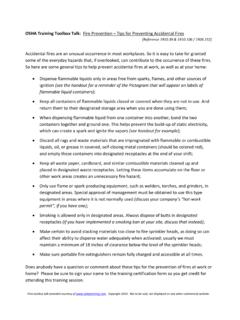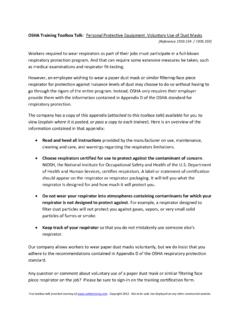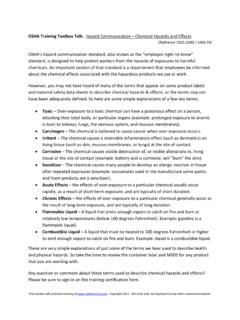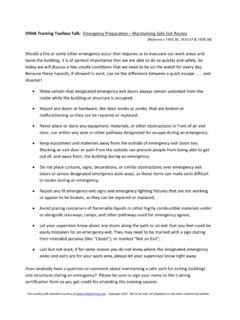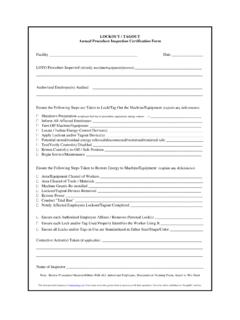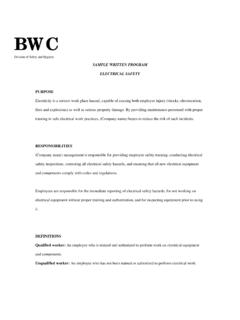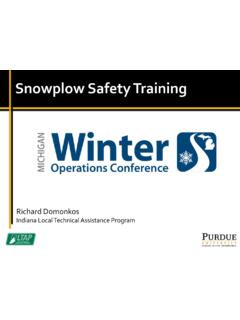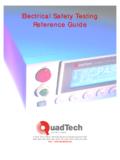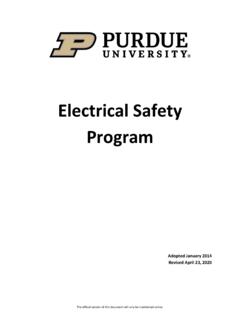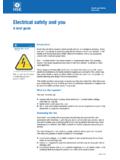Transcription of OSHA Training Toolbox Talk: Basic Electrical Safety ...
1 Free Toolbox talk provided courtesy of Copyright 2018. Not to be sold, altered, or displayed for profit on any commercial website. OSHA Training Toolbox Talk: Basic Electrical Safety Avoid Misuse of Extension Cords [Reference 1910 Subpart S / 1926 Subpart K] Think of all the activities we perform at work that would be so much more difficult, if not impossible, to do without electricity. Unfortunately there is not always an Electrical receptacle located nearby to directly plug our tools or equipment into, so we often utilize an extension cord to get power to the area where we are working. And while we seldom give them a second thought, the safe selection and use of an extension cord does require that we avoid certain hazardous conditions: Overloading an Extension Cord Extension cords are designed for a certain amount of electricity to be drawn through the cord (usually expressed as amps , or amperage).
2 Overloading an extension cord by using it to power equipment that draws too much current can cause the cord to over-heat and short out. So check your extension cord to determine the maximum amperage for which the cord is rated, and compare that to the amperage drawn by the equipment attached to that cord so you can avoid overload situations. It may be necessary to get a heavier cord to handle the load Using Extension Cords in Place of Permanent Wiring Extension cords are intended to be used as a temporary source of power (usually considered to be 30 days or less). But in some situations, you will find extension cord that have been strung through rafters, attached along a wall, or run through a chase-way or trough on a long-term basis to provide a permanent supply of power to a piece of equipment or machinery. This is not allowed! Running Extension Cords Through Windows, Doorways, and Other Openings If the window or door gets closed on an extension cord, or if the cord gets moved back and forth repeatedly, it can become pinched or weakened and break the insulation on the wiring.
3 This condition could then expose energized Electrical conductors inside the cord that could short out, or even electrocute a person if they make contact with the damaged area. Using Extension Cords Rated for Indoor Use Outdoors Extension cords intended for indoor use only are not designed to stand up to extreme outdoor conditions, such as cold, ice, wetness, or excessive heat. These conditions can weaken the cord and cause it to deteriorate, which could lead to excessive heat build-up and an overload situation. Check the tag on the cord or the packaging it came in to determine if it is, or is not, designated for outdoor use. Leaving Unsafe Extension Cords in service If you find an extension cord that is being used improperly, or is damaged, please notify your supervisor immediately, or unplug the cord and turn it in to the person(s) responsible for replacement and/or repair (discuss who that is for your workgroup). DO NOT attempt to repair an extension cord unless you are specifically authorized to do so.
4 Does anyone have an example of any other ways you have seen an extension cord improperly utilized on the job? Thank you for attending, and please sign your name on the Training certification form so you get credit for attending today s OSHA Training Toolbox talk. Free Toolbox talk provided courtesy of Copyright 2018. Not to be sold, altered, or displayed for profit on any commercial website. OSHA Safety Training CERTIFICATION FORM Toolbox Topic Covered: Basic Electrical Safety Avoid Misuse of Extension Cords Company Name: _____ Date: _____ Training led by: _____ PRINT NAME SIGNATURE _____ _____ _____ _____ _____ _____ _____ _____ _____ _____ _____ _____ _____ _____ _____ _____ _____ _____ _____ _____ _____ _____ _____ _____ _____ _____ _____ _____


